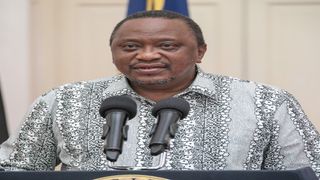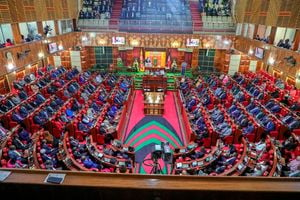
President Uhuru Kenyatta.
| Samuel Miring'u | Nation Media GroupBusiness
Premium
Sh3trn spending plan reveals Uhuru's priorities
The Consolidated Fund Services (CFS), from which the State draws cash to repay public debt as well as meet other constitutional obligations such as retired civil servants’ pensions, has received a whopping Sh724.5 billion; the single-biggest allocation of the different expenditure items listed in Treasury Cabinet Secretary Ukur Yatani’s budget.
The annual budget is ordinarily a strong indicator of any government’s top priorities, given the fact that resources are one of the key determinants of quality of service or development projects.
"Under-performance of the economy worsens the debt indicators, thus unsustainability. However, with fiscal consolidation, the government aims to contain the pace of borrowing and hence reduce the debt ratios," CS Yatani says in the Budget Policy Statement (BPS) document released on Monday.
Marginal growth
The education sector will cumulatively receive Sh510.5 billion, a marginal growth from the Sh505.1 billion allocated in the current financial year, making Education Cabinet Secretary Prof George Magoha controller of the biggest budget in the coming financial year.
The energy, infrastructure and ICT expenditures will grow by 10 per cent to a total of Sh401.2 billion, in keeping with the Jubilee administration’s massive expenditure on roads and power connections. The education sector is dealing with unprecedented challenges from the Covid-19 pandemic, which requires urgent expansion of learning facilities.
The sector’s budget is, however, nearly at the same level as this year, indicating learners and tutors should not expect any major changes in their environment.
The Sh401.2 billion infrastructure budget will make CS James Macharia the second-most important man to watch in terms of budget allocations.
Most powerful
Given that his ministry mostly spends most money on contracts and not salaries, he will remain the most powerful minister in the Jubilee administration in money terms. Interior CS Fred Matiang'i will also be leading a ministry with one of the fastest growing budgets.
Keeping law and order will gobble up Sh216 billion, while the National Security sector that includes the Ministry of Defence will have its budget grow by 10 per cent to Sh170 billion.
The agriculture sector has also witnessed a major jump in its budget, increasing by 10 per cent to Sh70 billion.
Despite the growth in the agriculture spending, it is still a drop in the ocean compared to the significance of the sector to the economy and the proportion of the population that relies on the sector. The health sector will receive Sh119.8 billion, a 7 per cent growth from the current budget, while governance, justice, law and order will see its outlay swell by 9 per cent to Sh216.2 billion.
The social protection, culture and recreation will see a marginal growth in its budget to Sh71.3 billion.
Low priority
Environmental protection will remain a low priority in the Jubilee administration’s Sh3.02 trillion budget plan.
The Ministry of Environment, Judiciary, general economic and commercial affairs sectors will receive budget cuts in the coming financial period.
The Sh80 million cut on the Judiciary budget to Sh17.9 billion, though marginal, is likely to set up the Judiciary against the Executive once more, given the fact that despite the total budget growth, the Executive has been slashing the Judiciary’s outlay. The cuts have been blamed for the slow delivery of justice.
The general economic and commercial affairs sector will see a 16 per cent cut in its budget to Sh23.3 billion, while the environmental protection, water and natural resources sectors will receive Sh102.8 billion, two per cent lower than the Sh105 billion in the current financial year.
Major concern
The environment remains a major concern in Kenya, with rising lakes, floods and pollution of rivers and lakes reaching dangerous levels for aquatic life and posing great danger to downstream populations.
This year's budget is set to put a fresh strain on Kenyans’ pockets, coming at a time when the government is fast running out of the headroom to borrow.
The 2021/22 expenditure plan is Sh216 billion or 7 percent more than the Sh2.81 trillion outlay in the current financial year.
From this, the executive will get Sh1.92 trillion. Parliament will receive Sh37.8 billion while counties will get Sh326.5 billion.
CS Yatani has listed the sustainability of public debt as one of the four major risks facing the execution of its new fiscal plan for the year that starts on July 1.
The other risks are defaults by parastatals on debts guaranteed by the government as well as fiscal risks related to devolution.
Increase risk
The BPS adds that contracting of new debt on short term maturities increases the refinancing risk, but the government strategy is to restructure the maturing loans for external and domestic with loans of longer-term maturities.
"The government will continue with active liability management operations in the domestic debt primary market by switching short term domestic debt to longer term domestic debt, with the aim of lengthening the maturity structure," the document says.
The document adds that Kenya faces a fiscal risk as the shilling continues to depreciate due to the fact that 51 per cent of the debt is held in external currencies.
"This has led to increase in debt service budget in local currency and also increase on the stock of debt without inflows. The ongoing global Covid-19 shock has worsened the debt indicators however, this is expected to be temporary as global economy recovers from the crisis."





